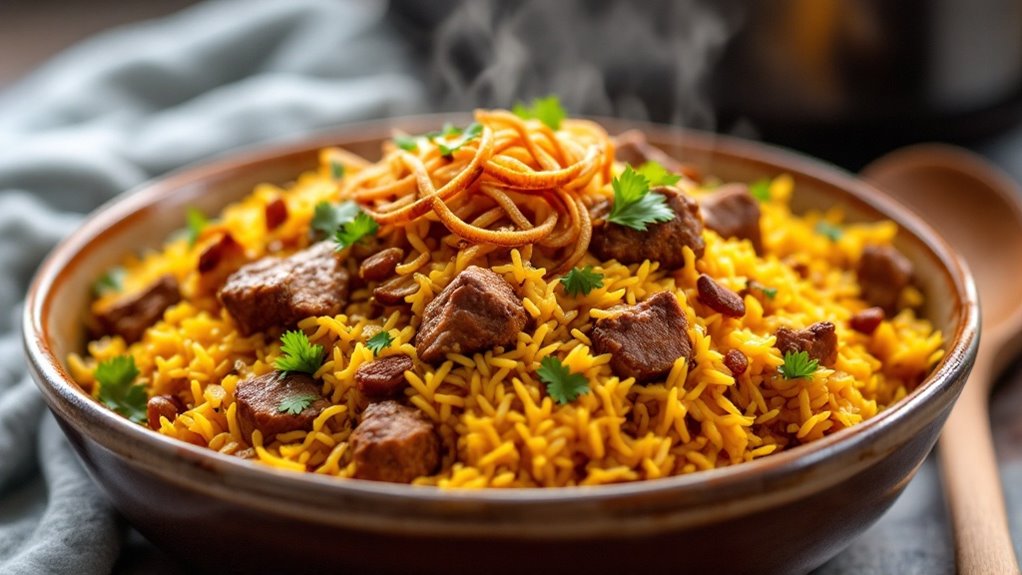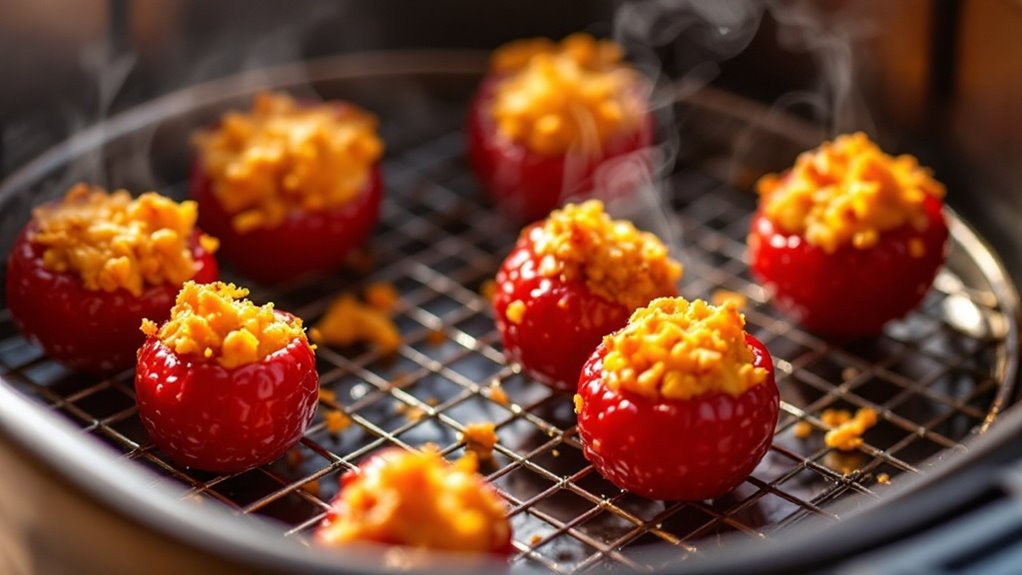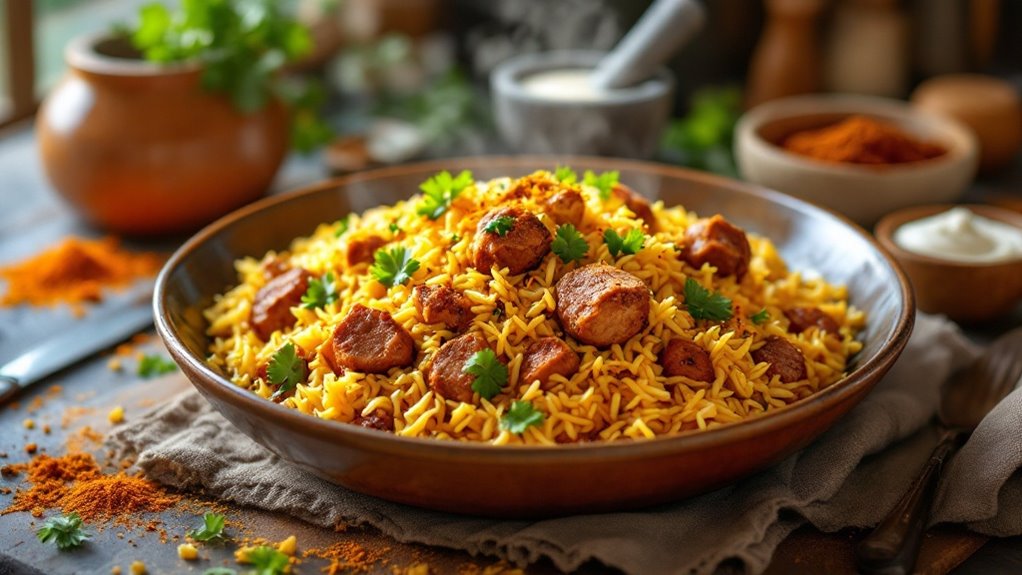Mastering the art of timing in the kitchen isn't just about following a recipe—it's about understanding the nuances of what's on your cutting board. You'll find that adjusting cooking times hinges on factors like size, thickness, and moisture content, but it's the interplay of these elements that can make or break your dish. Whether you're working with a dense roast or delicate vegetables, the key lies in knowing how to adapt. So, how do you guarantee everything comes out perfectly without overcooking or undercooking? The answer might surprise you, and it starts with a few simple adjustments.
Key Takeaways
- Adjust cooking times based on food thickness; thicker cuts require longer, slower heat, while thinner pieces cook faster.
- Monitor internal temperatures with a thermometer to ensure safe and accurate doneness for meats, poultry, and fish.
- Consider moisture content; high-moisture foods need longer cooking to evaporate liquid, while low-moisture ingredients require rehydration.
- Use appropriate equipment; cast-iron skillets and metal pans cook faster than glass or ceramic dishes.
- Rotate or reposition food during cooking to ensure even heat distribution and prevent uneven results.
Understanding Food Size and Thickness
When adjusting cooking times, the size and thickness of your food are critical factors to evaluate. Start by examining the food portion size—larger cuts require more time to cook through, while smaller pieces cook faster. Use a ruler or measuring tape for thickness measurement, especially for proteins like steaks or chicken breasts. Thicker cuts need longer cooking to guarantee even heat penetration, while thinner ones cook quicker but risk drying out if overcooked. For example, a 1-inch steak will take less time than a 2-inch one. Always adjust heat levels accordingly; thicker items benefit from lower, slower cooking to avoid burning the exterior. Keep in mind that irregular shapes may cook unevenly, so monitor closely and rotate as needed. Precision in sizing guarantees consistent results.
Adjusting for Moisture Content
Moisture levels in your ingredients greatly affect cooking times, so you'll need to adjust accordingly. Foods with higher moisture content, like vegetables or marinated meats, often require longer cooking to evaporate excess liquid, while drier items cook faster. Use techniques like patting ingredients dry, reducing liquids, or covering dishes to control moisture and achieve consistent results.
Understanding Moisture Levels
To achieve consistent results in cooking, it's essential to account for moisture content, as it directly impacts texture and cooking time. Foods with high moisture, like vegetables or meats, require adjustments to prevent overcooking or drying out. Use moisture retention strategies such as covering dishes with lids or foil to trap steam, or basting to maintain surface hydration. Conversely, low-moisture ingredients, like dried beans or grains, often need longer cooking times to rehydrate properly. Analyze humidity effects in your kitchen—high humidity can slow evaporation, while low humidity speeds it up. Adjust your methods accordingly, like reducing liquid in humid conditions or adding more in dry environments. Understanding these dynamics guarantees your dishes turn out perfectly every time.
Impact on Cooking Duration
Since moisture content directly influences how long food takes to cook, you'll need to adjust your timing based on the ingredient's water levels. Foods with high moisture, like vegetables, cook faster because water conducts heat efficiently. Conversely, dense, low-moisture ingredients, such as root vegetables or meats, require longer cooking times to break down their structure. Pay attention to food density impact—thicker cuts or tightly packed ingredients slow heat penetration. Ingredient composition also matters; proteins and starches absorb moisture differently, altering cooking durations. For example, a juicy tomato will soften quicker than a dry potato. Always monitor texture and doneness, as moisture levels can vary even within the same ingredient. Adjust heat and time accordingly to achieve consistent results.
Techniques for Moisture Control
When you're aiming to control moisture in your cooking, start by understanding how to manipulate water content for desired results. For steam retention, cover dishes tightly with lids or foil to trap moisture, ensuring tender, juicy outcomes. Conversely, remove lids or vent covers to reduce humidity control and achieve crispier textures. Adjust oven temperatures—lower heat with added liquid keeps foods moist, while higher heat evaporates excess moisture for browning. Use salt to draw out water from vegetables or proteins, or brine them to retain moisture during cooking. For baked goods, balance wet and dry ingredients precisely to avoid sogginess or dryness. Monitor cooking times closely, as overexposure to heat can dry out foods, while undercooking may leave them too wet.
Adapting to Cooking Methods
Cooking methods substantially influence how long your dish takes to prepare, so adjusting times is essential for perfect results. When switching between methods, consider heat distribution and your cooking vessel. For example, a cast-iron skillet retains heat better than a thin stainless steel pan, so you'll need less time to sear or sauté. If you're baking, a glass dish heats more slowly than metal, so increase the cooking time slightly. Grilling over direct heat cooks faster than indirect, so monitor closely to avoid overcooking. Steaming requires less time than boiling, as the steam's consistent temperature cooks food more efficiently. Always check for doneness using a thermometer or visual cues, as these adjustments guarantee your dish turns out perfectly, no matter the method.
Factoring in Oven Temperature Variations
Check your oven's calibration regularly, as even a slight temperature discrepancy can affect cooking times and results. Use an oven thermometer to monitor accuracy and adjust your settings accordingly. Understanding how temperature variations impact your dishes guarantees consistent outcomes and prevents undercooking or overcooking.
Oven Calibration Importance
Since ovens often don't maintain the exact temperature set on the dial, calibrating yours secures consistent cooking results. Start by performing oven accuracy checks using an oven thermometer. Place it in the center of the oven, preheat to a specific temperature, and compare the thermometer reading to the set temperature. If there's a discrepancy, adjust the oven's calibration dial or consult the manual for recalibration steps. For calibration frequency tips, check your oven every six months, especially if you notice uneven cooking or longer-than-expected bake times. Regular calibration confirms your oven heats accurately, preventing undercooked or overcooked dishes. A well-calibrated oven is essential for precise cooking times, especially when working with recipes that demand exact temperatures. Don't skip this step—it's a game-changer for reliable results.
Temperature Impact Analysis
When your oven's temperature fluctuates, it directly affects how your food cooks, often leading to uneven results or extended cooking times. To manage this, perform a heat distribution analysis by placing an oven thermometer in different spots to identify hot and cold zones. Adjust your cooking times based on these findings, rotating dishes halfway through for even cooking. Consider thermal conductivity effects—thicker or denser foods retain heat longer, so reduce the temperature slightly and extend cooking times. For delicate items like pastries, maintain consistent heat by preheating thoroughly and avoiding frequent door openings. Use convection settings if available, as they improve airflow and reduce temperature inconsistencies. Regularly calibrate your oven to guarantee accuracy, and always monitor food progress to avoid overcooking or undercooking.
Monitoring Internal Temperatures
To guarantee your food is cooked safely and to the desired doneness, monitoring internal temperatures is essential. Use a reliable temperature probe to check the thickest part of the food, avoiding bones or fat, which can skew readings. Insert the probe slowly and confirm it reaches the center for accurate results. Heat distribution varies across ovens, stovetops, and grills, so rotate or reposition food as needed to promote even cooking. For meats, poultry, and fish, refer to USDA-recommended safe temperatures to prevent undercooking. Keep the probe clean between uses to avoid cross-contamination. If you're cooking multiple items, check each one individually, as thickness and density affect cooking times. Consistent monitoring guarantees precision and prevents overcooking, preserving texture and flavor.
Testing for Doneness Accurately
While monitoring internal temperatures is essential, testing for doneness accurately involves more than just relying on a thermometer. Use doneness indicators like visual cues, touch, and texture assessment to guarantee your food is cooked perfectly. For meats, press the surface gently—firmness indicates doneness, while a springy feel suggests it's undercooked. Check poultry juices; they should run clear, not pink. For baked goods, insert a toothpick; it should come out clean or with a few crumbs. Pasta should be al dente, tender but with a slight bite. Vegetables should be crisp-tender, not mushy. Always let proteins rest; they'll continue cooking off the heat. Combine these methods with temperature checks for the most reliable results, making certain your dishes are both safe and delicious.
Disclosure: As an Amazon Associate, I earn from qualifying purchases.



